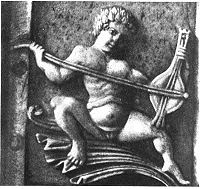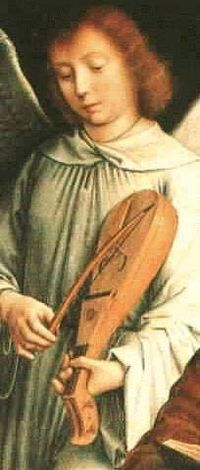List of European medieval musical instruments
This article needs additional citations for verification. (February 2017) |
| Part of a series on |
| Medieval music |
|---|
| Overview |
|
|
This is a list of medieval musical instruments used in European music during the Medieval period. It covers the period from before 1150 to 1400 A.D. There may be some overlap with Renaissance musical instruments; Renaissance music begins in the 15th century.
Percussion
[edit]| Names and variations | Description | Ethnic connections, regions | Pictures | Pictures |
|---|---|---|---|---|
| Adufe[1] | A frame drum brought to Iberia by Muslims and played mainly by women.[2] Used in the charamba in Portugal, a circle dance for couples.[2]
The adufe is a square or rectangular frame drum usually made of pine, over which is mounted a goat's skin. The size of the frame usually ranges from 12 to 22 inches on each side, and 1 to 2 inches thick. The skin is stitched on the sides, with the stitches covered by a coloured ribbon. In the interior small seeds or small stones are placed to make pleasing sounds. |
Iberia Portugal Spain |
 |
  |
| Bells |  |
 | ||
| Bumbulum (legendary) | ||||
| Clappers
cliquettes |
Clappers from the Carolingian Empire appear to have been disks or possibly chimes attached to sticks. Other versions were blocks of wood held in the palms. The palm-held blocks could make clicking and rattle noises like castanets. Other similar instruments worldwide include the Thai/Cambodian krap sepha, Indian/Nepali khartal, Uzbek/Tajik qairaq, or North African krakebs. |   |
  | |
| Cymbals |  |
  | ||
| *Frame drum | ||||
| Jew's harp[3] | ||||
| Nakers |  | |||
| Pandeiro[4] | ||||
| Tabor
Pipe and tabor |
A three-hole pipe or reed pipe paired with a snare drum, the musician playing both at once. A variation of this is the Tambourine de Bearn, in which a dulcimer or string drum replaces the snare drum. |  |
 
| |
| Tof | Tof was the Hebrew instrument which Miriam played, "most commonly translated" into English as timbrel[6] Near eastern origin, used by Gauls, Greeks, Romans (tympanum), Egyptians, Assyrians. [7] Jingles were probably originally separate from this instrument.[7] Also related to Daff.[7] |  |
 | |
| Triangle |  |
String instruments
[edit]| Names and variations | Description | Ethnic connections, regions |
Pictures | |
|---|---|---|---|---|
| Citole[8][9] |  | |||
| Dulcimer | A box zither; see psaltery.
"Little is known of the dulcimer before the mid-15th century."[10] Earliest known depiction is on ivory carving for book cover, 12th century A.D.[10][11] |
 | ||
| Fiddle see also |  | |||
| Gittern[9] |  | |||
| Guitarra latina | One writer has summed up the guitarra latina, which is not well defined, saying "For musicians in Alfonso’s time it may have meant only 'a plucked stringed instrument: not the Muslim one.'"[12] |  |

| |
| Guitarra morisca[13] |
  |
 | ||
| Medieval harp (Medieval form of the modern harp) |  |
 | ||
| Lute[14] |  |
 | ||
| Lyra | Fiddle, related to rebec |  |
 | |
| Lyre |  |
 | ||
| Organistrum (large form of medieval hurdy-gurdy) |   |
   | ||
| Psaltery |   |
  | ||
| Rabel | Fiddle, probably variation of rebec. Survives today in Basque speaking areas; historically had leather soundboard; modern instruments may have wooden soundboard. The instrument traveled to the Spanish colonies in America, where it can be found today in Panama. |     |
    | |
| Rebab
Rabé morisco |
Rebab is a word for various kinds of fiddle in the Muslim world. Spelling is loose, because Arabic does not write down vowels sounds. Rabab, rebab, rubab, ribab have all been used, and some of them are used for plucked instruments in Asia as well. |   |
  | |
| Rebec[16] |  |
 | ||
| Rotte |  | |||
| Vielle
Vièle |
  |
  | ||
| Vihuela de arco
Vihuela de arco pequeña (small bowed vihuela) |
The vihuela de arco may be a variant of the vielle. Spain had a variety of fiddles (which predate the violin) in the cathedral artwork and manuscript miniatures. |  |
  | |
| Zither | ||||
Wind instruments
[edit]| Names and variations | Description | Ethnic connections, regions | Pictures | Pictures |
|---|---|---|---|---|
| Albogón[19] | Double-reed instrument or type of shawm, possibly adapted from Muslim al-buq horn.[20] |  | ||
| Alboka | Spanish hornpipe. The musician blowns into a horn cup, which channels his breath through one or more single reeds. Each reed is connected to pipe with fingerholes. |  |
 | |
| Bagpipes[21] |  |
  | ||
| Bladder pipe |  |
 | ||
| Bombard | Bagpipe of Brittany | |||
| Buisine
Anafil |
Europeans used horns for trumpets until adapting the Muslim nafir. It was renamed the anafil in Spain and the buisine in France. Europeans developed the instrument further into the herald trumpet or clarion near the end of the medieval period. |  |
 | |
| Clarion | Clarion today implies high, angelic, pealing notes. That sound was developed, however, as Europeans began to learn to shape and bend sheet-metal tubes. Earlier Europeans showed angels playing horns. |   |
  | |
| Cornett | Although known mainly in the 1500ss-1600s, cornett-like instruments were known in the medieval period. Possibilities for medieval horns include long sheep horns. Possibly the instruments depicted in illustrations are hornpipes, long reeds made into pipes with fingerholes and attached to horns. |  |
 | |
| Crumhorn | ||||
| Flageolet | ||||
| Flute |  | |||
| Gemshorn | Fingerhole horn, related to cornett. |  | ||
| Horn
Hunting horn Signal horn Battle horn |
Trumpets made from cattle horns (or from other materials and shaped like cattle horns). Carved ivory horns of this style were called oliphants. |   |
  | |
| Organ | ||||
| Portative Organ |  | |||
| Recorder | ||||
| Reed pipes
Clarinet Launeddas |
Europeans made pipes out of reeds, splitting a reed to make a single reed. A single 3-hole reed pipe could be used for the pipe and tabor. The Launeddas was a more elaborate reed pipe, with multiple pipes; each might have its own reed or one reed might sound multiple pipes.
Reed pipe traditions around the world include Asia, Southeast Asia, the Middle East and Africa. |
 |
 | |
| Sackbut[23] | Renaissance instrument, ancestor of the trombone. Medieval variant was clarion | |||
| Shawm[24]
oboe |
Double-reed instruments. The reed bundle is inserted through a disk (used for breath control, for uninterrupted sound, playing while the musician breathes.) |  |
  | |
| Tabor Pipe | A two or three-hole pipe of wood or reed, played with the tabor; the combination is called pipe and tabor. Three-hole flutes have two front finger holes and one back thumb hole. |  |
  |
Gallery
[edit]References
[edit]- ^ Gutwirth, Eleazar (1998). "Music, Identity and the Inquisition in Fifteenth-Century Spain". Early Music History. 17: 161–181. doi:10.1017/S0261127900001637. ISSN 0261-1279. JSTOR 853882.
- ^ a b Schechter, John M. (1984). "Adulfe". In Sadie, Stanley (ed.). The New Grove Dictionary of Musical Instruments. Vol. 1. p. 25.
- ^ The Jew's harp : a comprehensive anthology. Leonard Fox. Lewisburg: Bucknell University Press. 1988. ISBN 0-8387-5116-4. OCLC 16356799.
{{cite book}}: CS1 maint: others (link) - ^ Mauricio Molina (2006). Frame Drums in the Medieval Iberian Peninsula. pp. 101–. ISBN 978-0-542-85095-0. Retrieved 25 December 2012.
- ^ "TIMBREL - JewishEncyclopedia.com". Jewishencyclopedia.com. Retrieved 2016-05-13.
- ^ Sadie, Stanley, ed. (1984). "Timbrel". The New Grove Dictionary of Musical Instruments. Vol. 3. p. 585.
- ^ a b c Sadie, Stanley, ed. (1984). "Tambourine". The New Grove Dictionary of Musical Instruments. Vol. 3. p. 511.
- ^ [1] [dead link]
- ^ a b Baker, Paul. "The Gittern and Citole". Retrieved 4 December 2016.
- ^ a b Kettlewell, David (1984). "Dulcimer". In Sadie, Stanley (ed.). The New Grove Dictionary of Musical Instruments. Vol. 1. p. 627.
- ^ "A marvel in gold and ivory: Queen Melisende's Psalter". 26 May 2022.
[Caption for photograph of the book cover. The dulcimer is in bottom right corner of book-cover carving] The Melisende Psalter, Upper cover with scenes from the life of David: Egerton MS 1139/1
- ^ Bouterse, Curt. "Medieval Instruments V: Fiddles – Curt Bouterse".
- ^ Galpin, Francis William (1911). Old English Instruments of Music. Chicago: A. C. McClurg and Company. pp. 21–22.
- ^ "A Panoply of Instruments for Medieval, Renaissance, and Baroque Music". Music Educators Journal. 65 (9): 38–69. 1979. doi:10.2307/3395616. ISSN 0027-4321. JSTOR 3395616.
- ^ Brown, Howard Mayer (1984). "Symphonia". In Sadie, Stanley (ed.). The New Grove Dictionary of Musical Instruments. Vol. 3. p. 483.
- ^ Spohnheimer. "The Rebec". Music.iastate.edu. Archived from the original on 2016-05-04. Retrieved 2016-05-13.
- ^ "Título uniforme [In Apocalipsin] Title Beati in Apocalipsin libri duodecim". bdh.bne.es. BIBLIOTECA DIGITAL HISPÁNICA. Retrieved 10 December 2016.
- ^ "Título uniforme [In Apocalipsin] Title Beati in Apocalipsin libri duodecim". bdh.bne.es. Biblioteca Digital Hispánica. Retrieved 10 December 2016.
- ^ a b Centre Int. de la Música Medieval. "ALBOGÓN. Ms. b.I.2. fol. 268v. RBME. Cantiga de Santa María 388". youtube.com.
[note: video of a modern recreation of the Albogón
- ^ a b Bouterse, Curt. "Medieval Instruments VI: Winds".
Another unusual instrument depicted in the Cantigas is the albogón. This was derived from the Arabic al-buq, originally a generic word for horns and trumpets, but latterly restricted to horns. Supposedly, in the 10th century, during the reign of the Spanish Umayyad caliph, al-Hakam II, a horn was fitted with a double reed and fingerholes...Cantiga 300 shows a huge one being played, accompanied by an hourglass-shaped drum.
- ^ Jones, G. Fenwick (1949). "Wittenwiler's "Becki" and the Medieval Bagpipe". The Journal of English and Germanic Philology. 48 (2): 209–228. ISSN 0363-6941. JSTOR 27713052.
- ^ Bouterse, Curt. "Medieval Instruments VI: Winds".
- ^ Spohnheimer. "The Sacbut". Music.iastate.edu. Archived from the original on 2016-05-04. Retrieved 2016-05-13.
- ^ Spohnheimer. "The Renaissance Shawm". Music.iastate.edu. Archived from the original on 2016-05-25. Retrieved 2016-05-13.
This list of songs or music-related items is incomplete; you can help by adding missing items. (October 2021) |




